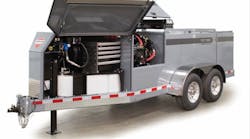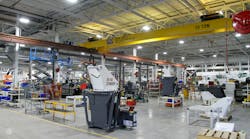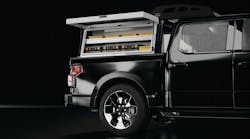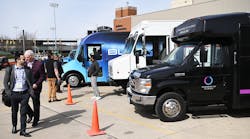“WHAT THE HECK IS MULTIPLEXING?”
Cary Coverdill, Freightliner's engine multiplexing expert, said that's the question he hears all the time. He says that many people don't understand it, even though it's very common in automobiles today and has been in trucks since 1995.
“The best example of it in your home is broadband cable,” he said in his presentation at the Truck Product Conference. “We have Internet access, cable TV, and telephone, and it's all coming in one pair of wires.”
The term “multiplexing” describes how the vehicle's electrical system works. Multiplexing is defined as sending multiple electronic messages through the same signal path at the same time — in this case, through the vehicle's wiring.
Multiplexing allows a vehicle's electrical system to simultaneously perform tasks and to monitor components. A multiplexed system uses electronic control modules to operate the system, with the modules interpreting different messages being transmitted on the same wire. The electrical system components, such as switches and lamps, are connected to the control modules, which collect and control all information about the components by communicating on the data bus.
Multiplexing components were introduced in vehicles in the 1980s with the advent of electronically controlled engines and the J1708/J1587 data bus. Then, in the early 1990s, transmissions were electronically connected to engines in order to control engine speed and torque output during shifting. A few years later came traction control, which works in conjunction with ABS to control wheelspin.
Coverdill said Freightliner took it one step further in the Business Class M2, with multiplexing now being applied to the entire vehicle. The J1939 system on Freightliner's M2 doesn't just receive information; it encodes it from seven switches and puts it onto the data link to go the bulkhead module.
Primary data bus
J1939 is the primary data bus (also known as the “backbone”) and is used for all control messaging and troubleshooting. It is the high-speed communication data bus that provides the means for the control modules to exchange information between each other.
Much of the messaging on this data bus is raw data transmitted from one module to others that require the information. The engine controller monitors coolant temperature and broadcasts that information on the data bus. The instrument cluster receives the information and displays it on the instrument cluster temperature gauge.
J1939 consists of a twisted pair of yellow and green wires. The J1939 data bus must have a terminating resistor at each end. There can't be any open tee connector cavities. If J1939 communication is lost — for example, if a connector becomes disconnected — the hazard lights will flash, the right headlamp will remain on, and the dash cluster will display “No J1939.”
J1708/J1587 is the secondary data bus and is used for limited troubleshooting. Fault codes are displayed on the instrument cluster display, and also may be viewed on ServiceLink. J17087/J1587 consists of a twisted pair of orange and green wires. If this data bus loses communication, the dash cluster will display “No Data.”
The multiplexed system utilizes these controllers: the Bulkhead Module (BHM), Chassis Module (CHM), and an optional Expansion Module (EXM). The most important part of the multiplexed electrical system is the BHM, the “brain” of the entire system, controlling all of the outputs in response to changes in any of the inputs. The CHM and EXM are “slaves” to the BHM and respond to commands from the BHM and broadcast the status of the inputs and outputs connected to them.
The multiplexed electrical system reduces vehicle wiring by utilizing a distributed and “chain of command” approach to handling switch inputs and controlling electrical load outputs. The control modules transmit messages by controlling the voltage difference between the two wires of the data buses. By changing the voltage differential in a patterned format, other modules can interpret the signal as an informational message. Any module on the data bus may transmit a message if the data bus is free.
If more than one module tries to transmit at the same time, the signals become unreadable to other receiving modules. Therefore, a message protocol is programmed into all of the modules on the data bus that instructs the modules on message priority. When a message is transmitted, the first portion of the message informs the other modules of the message priority. The control module preparing to send the highest priority message will be allowed to transmit while the other modules withdraw their messages until the data bus is free.
All of the control modules connected to the data bus can “hear” all of the messages being sent. The information contained in the message will determine if a particular module will “listen” to that message. If a message being transmitted on the data bus doesn't contain information required by a receiving module, that module disregards the message without any further processing.
“This is where the multiplexing system really stands out,” Coverdill said. “It's not the same as a hard-wired switch where the current follows the wire down to a device, which then turns on. With the multiplexing system, you turn on a Smart Switch, which activates a chain of events that can use logic that's held within the bulkhead module.
“For PTOs: Do you want to check whether the parking brake is set before engaging the PTO? Do you want to check whether you have an Allison automatic transmission in neutral? Do you want to check that the engine RPMs are below a certain value before engaging the PTO? While the switch is in the engaged position, there's a blinking light when the PTO engages, and it senses the clutch has engaged.”
Smart Switches
He said there are 92 different Smart Switches that can be programmed.
“That doesn't mean we only have 92 functions,” he said. “It means we have a recognizable unique Smart Switch that can be used for 92 different operations. We have 92 different recognizable switches, and the ability to program how the system responds to each switch. We have a tremendously powerful system.”
He said there are up to five on a base truck. All M2s have an interconnect device that provides access to high-current megafuses. Inside the center of the dash, there's a cover that can be taken off. There are splice connectors that provide battery power, electrical ground, dash ground, and variable voltage for instrument-panel lights and ignition power. Each power point is capable of supplying five amps of power.
He said that for most vocational applications, the user should go with a high-current side option with PDM. There are two options for each configuration. The two PDMs are for hooking up a standard seven-way tractor-trailer connector and body-lighting PDM. They look virtually identical, with the biggest difference being that the trailer PDM is equipped to handle a typical J560 seven-way tractor-trailer connector.
“In the industry of on-highway, that is always set up with separate turn and brake lamps,” he said. “However, the body-lighting PDM is set up to follow the configuration of the chassis of the truck. Most chassis are set up with combo tail lights at the end of the frame. The body-lighting PDM will follow how the chassis is configured.
“You can order a truck configuration for separate stop and turn. You see that mostly when someone is going to put on a pickup/delivery body or a dump body, where they're going to have narrow oval lights bump the side rails of the body and may have dump mechanism or liftgate mounted on the back of the chassis, so you can't leave the original chassis lights. In which case we usually see separate stop and turn lamps. It gives you better visibility and more clear indicators.
“If the chassis itself is configured for separate stop and turn, the circuits coming out of the body-lighting connector — the green connector, either low current or high current — will be separate stop and turn. It's going to match the way the chassis is configured. If you have a truck that also has a trailer connector, you'll have both. So if you need to access a different configuration of circuits, if you have a trailer PDM and a body PDM, the body PDM can be set up for combined stop and turn. The trailer is always stop and turn. You have everything you could hope for.”








